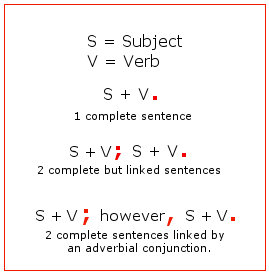Just ♥ Words—semicolons (part 2)
 Aah, look at Semiramis now—she's so much happier now that you've made a bit of progress in your mastery of the semicolon.
Aah, look at Semiramis now—she's so much happier now that you've made a bit of progress in your mastery of the semicolon.
For a refresher scroll down to the previous post. Remember: the gist of the semicolon is that it connects two sentences without using a comma and a conjunction (and, but, or, so, for nor, yet).
In our final lesson, we're using semicolons with conjunctions—words like however, therefore, or nonetheless. They're called ADVERBIAL conjunctions.
—Semicolons & ADVERBIAL Conjunctions—Why use a semicolon?
Remember: a semicolon connects two related sentences.Think of it as a combination of a period and a comma. Notice the mark has one of each—top & bottom.
What's a conjunction?
A conjunction is a word that "conjoins," or links, two complete sentences. Regular conjunctions—and, but, so, for or, nor, yet—require a COMMA before the conjunction.Example: The dog barked , and the cat hissed.
Example: The dog barked , but the cat stood its ground.
Example: The dog barked , so the cat ran.What's an adverbial conjunction?
Like regular conjunctions, adverbial conjunctions link two full sentences—but with a SEMICOLON before and a COMMA after. They're "adverbs" in that they describe precisely how the 2nd sentence relates to the 1st—the same way adverbs describe verbs. Remember adverbs?—> She ate. How did she eat? She ate SLOWLY.
—> He sang. How did he sing? He sang LOUDLY.
Some common adverbial conjuctions
also however nevertheless anyway indeed nonetheless consequently instead now finally likewise otherwise further meanwhile then furthermore moreover therefore
Examples—
• It was too cold to enjoy the game ; however , she decided to go anyway.
The adverbial conjunction "however" indicates that the 2nd part of the sentence is in OPPOSITION to the first part. You could also use...nevertheless or nonetheless or still.
__________
• It was too cold to enjoy the game ; therefore , she decided not to go.
The adverbial conjunction "therefore" indicates that the 2nd part of the sentence is a CONSEQUENCE of the 1st part. You could also use...as a result or consequently.
__________
• It was too cold to enjoy the game ; furthermore , she didn't feel well.
The adverbial conjunction "furthermore" indicates that the 2nd part of the sentence is an ADDITION to the 1st part. You could also use...also or moreover.
__________
• It was too cold to enjoy the game ; instead , she went to the library.
The adverbial conjunction "instead" indicates that the 2nd part of the sentence is an ALTERNATIVE to the 1st part. You could also use...rather.
CAUTION
Don't confuse adverbial conjunctions when they're used as strict ADVERBS. Notice that in the following sentences they're offset by COMMAS. There's not a semicolon in sight.
• It was too cold, however, for the game.
• However, it was too cold for the game.
"However" functions as an ADVERB—not an adverbial conjunction—because there is only one sentence here (S + V): "It was"...
__________
• She did not, therefore, want to go to the game.
•Therefore, she did not want to go to the game.
"Therefore" functions as an ADVERB—not an adverbial conjunction—because there is only one sentence here (S + V): "She did (not) want"...
__________
• Furthermore, she did not feel well.
"Furthermore" functions as an ADVERB—not an adverbial conjunction—because there is only one sentence here (S + V): "She did (not) feel"...
Site by BOOM
![]()
LitLovers © 2024

